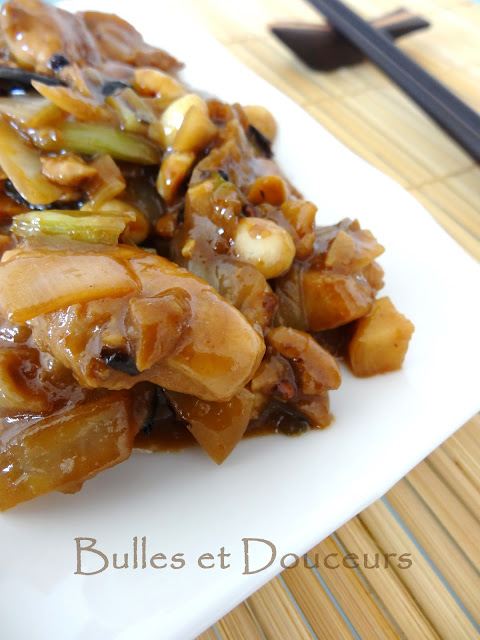Kung Pao or Gong Bao chicken originates from the chinese province of Sichuan. It is said it has been named after a late Qing Dynasty (late nineteenth-century) governor of Sichuan, Ding Baozhen, who is said to have particularly enjoyed eating it. Gong Bao was his official title. There are many versions given to its origins: some say it was a dish Ding Baozhen brought with him from his home province of Guizhou; others that he ate it in a modest restaurant when he went out in common dress to observe the real lives of his subjects. Others add that his chef invented the finely-chopped chicken dish because Ding Baozhen had bad teeth. Whatever its origins, its association with an imperial bureaucrat was enough to provoke the wrath of the Cultural Revolution radicals, and it was renamed "fast-fried chicken cubes" (hong bao ji ding) or "chicken cubes with seared chillies" (hu la ji ding) until its political rehabilitation in the 1980s. (Source-. Fuchsia Dunlop in "Sichuan Cookery")
Adapted from Sichuan Cookery of Fuschia Dunlop
Ingrédients:
Kunp Pao chicken can be hot, I have reduced the amount of chillies but if five is sound still hot for you, please reduce, but keep some chillies for the nice spiciness brought into the dish. I love the aroma of sichuan Pepper but hate biting into some when eating the gong bao...It is important to add peanuts at the very end of the cooking to keep their crispness. I actually usually serve them in a tiny bowl on the side, for my guest to add as they eat.
Adapted from Sichuan Cookery of Fuschia Dunlop
Ingredients:
350 g boneless chicken breasts
3 cloves of garlic plus equivalent amount of fresh Ginger, both peeled and thinly sliced
5 spring onions, white parts only, chopped
2 tablespoons groundnut oil
5 dried chillies, snipped in half
1 teaspoon whole Sichuan Pepper
75 g roasted peanuts
Marinade:
1/2 teaspoon salt
2 teaspoons light soy sauce
1 teaspoon Shaoxing wine or sherry
1.5 teaspoons potato flour
1 tablespoon water
Sauce:
3 teaspoons sugar
3/4 teaspoon potato flour
1 teaspoon dark soy sauce
1 teaspoon light soy sauce
3 teaspoons Chinkiang or Chinese black vinegar
1 teaspoon sesame oil
1 tablespoon chicken stock or water
Preparation:
1. Cut the chicken into small cubes. Place in a bowl and mix in the marinade ingredients.
2. Combine the sauce ingredients in a small bowl.
3. Put 2 tablespoons of oil in a wok and heat over high flame. When the oil is hot but not smoking, add the chillies and Sichuan Pepper and stir-fry briefly until they are crisp and fragrant. Try not to burn the spices.
4. Quickly add the chicken cubes and fry over a high flame, stirring constantly. When the chicken begins to turn white, add the ginger, garlic and spring onions and continue to stir-fry for a few minutes until fragrant and the meat is cooked through.
5. Give the sauce a stir and add it to the wok, continuing to stir and toss. As soon as the sauce has become thick and lustrous, add the peanuts, stir and serve.
* * * Poulet Kung-Pao * * *
Adapted from Sichuan Cookery of Fuschia Dunlop
Ingrédients:
350 g de blanc de poulet
3 gousses d'ail, plus l'équivalent de gingembre frais, tous pelés et hachés
5 oignons verts, n'utiliser que le blanc et émincer
2 càs d'huile d'arachide
5 piments séchés, fendus au milieu
1 càc de poivre du Sichuan
75 g de cacahuètes grillées
Marinade:
1/2 càc de sel
2 càc de sauce soja claire
1 càc de vin Shaoxing ou de xérès
1.5 càc de fécule de pomme de terre
1 càs d'eau
Sauce:
3 càc de sucre
3/4 càc de fécule de pomme de terre
1 càc de sauce soja foncée
1 càc de sauce soja claire
3 càc de Chinkiang ou vinaigre foncé chinois
1 càc d'huile de sésame
1 càs de bouillon de poulet ou d'eau
Préparation:
1. Couper le poulet fines lamelles. Placer dans un bol et ajouter les ingrédients de la marinade, mélanger.
2. Mélanger les ingrédients de la sauce dans un petit bol.
3. Mettre 2 cuillères à soupe d'huile dans un wok et laisser chauffer à feu vif. Lorsque l'huile est chaude mais pas fumante, ajouter les piments et le poivre de Sichuan et sauter brièvement jusqu'à ce qu'ils répandent leur parfum. Veiller à ne pas brûler les épices.
4. Rapidement, ajouter le poulet et faire sauter en remuant constamment. Quand le poulet commence à blanchir, ajouter le gingembre, l'ail et l'oignon vert et continuer à faire sauter quelques minutes jusqu'à ce que la viande soit bien cuite.
5. Verser la sauce dans la préparation du wok sans cesser de remuer. Dès que la préparation a épaissi, ajouter les cacahuètes et servir.



No comments:
Post a Comment